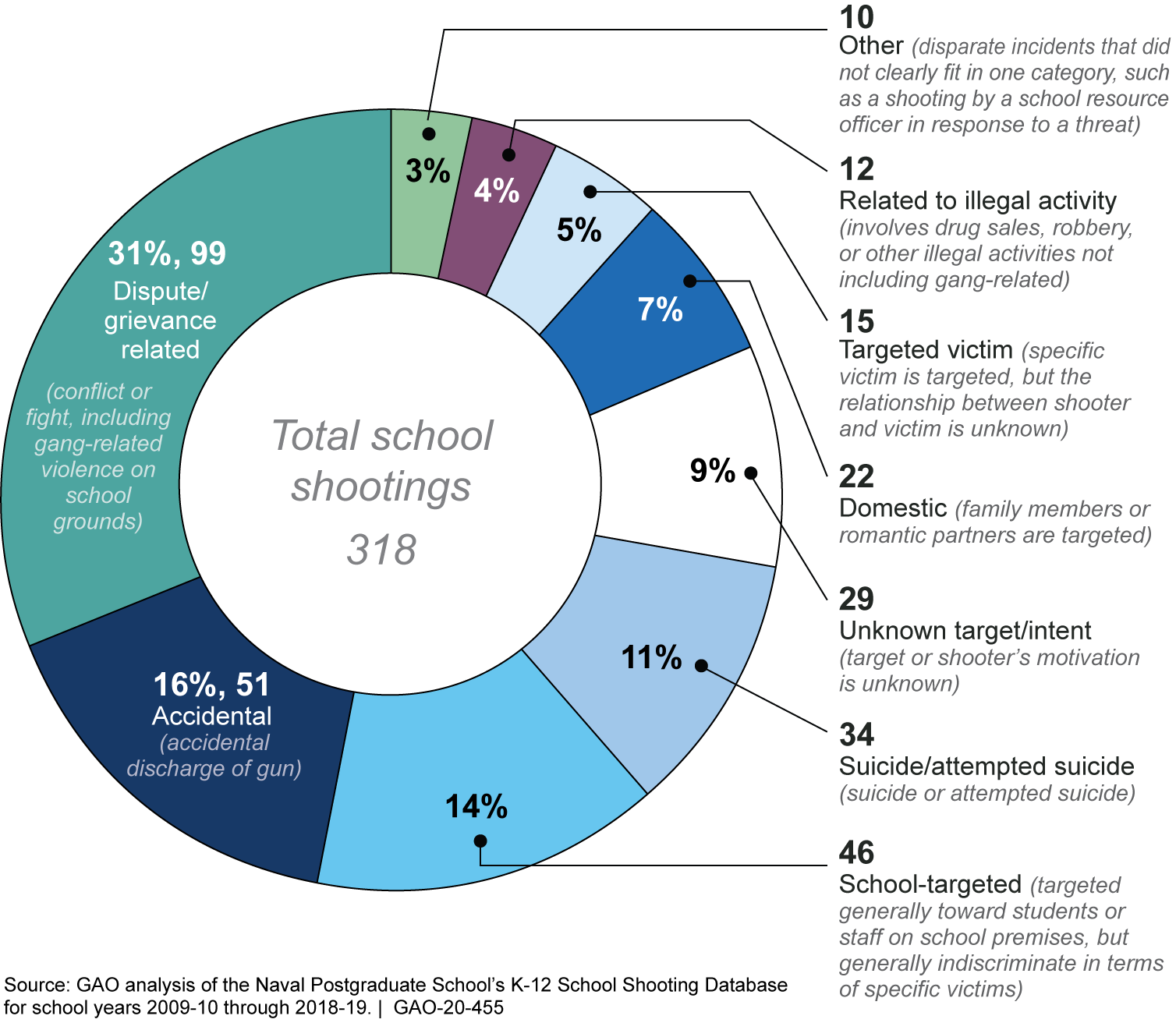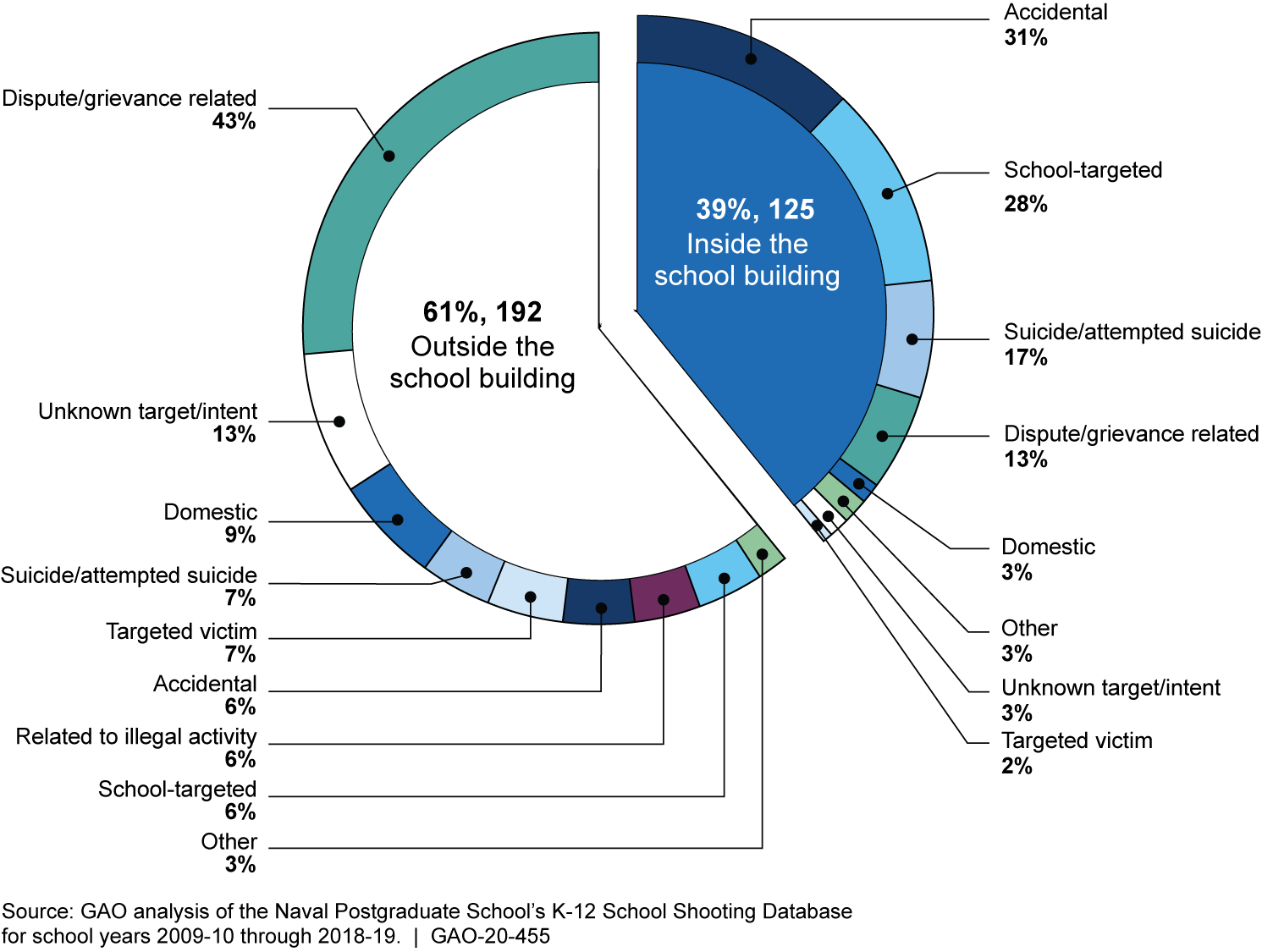K-12 Education: Characteristics of School Shootings
Fast Facts
We examined school shootings and found:
Half were committed by current or former students
Suburban and rural, wealthier, and low-minority schools had more school-targeted shootings; such shootings were the most fatal and most commonly committed by students
Urban, poor, and high-minority schools had more shootings overall and more motivated by disputes; these shootings were often committed by non-students or unknown shooters
More shootings happened outside, but those inside schools were usually more deadly
We found no empirical research from 2009-2019 that directly examined the link between school discipline and school shootings.
Map of K-12 School Shootings in the United States, School Years 2009-10 through 2018-19

U.S. map showing 63 shootings in western states, 71 in the midwest, 156 in the south, and 28 in the northeast
Highlights
What GAO Found
GAO found that shootings at K-12 schools most commonly resulted from disputes or grievances, for example, between students or staff, or between gangs, although the specific characteristics of school shootings over the past 10 years varied widely, according to GAO's analysis of the Naval Postgraduate School's K-12 School Shooting Database. (See figure.) After disputes and grievances, accidental shootings were most common, followed closely by school-targeted shootings, such as those in Parkland, Florida and Santa Fe, Texas.
K-12 School Shootings by Kind, School Years 2009-10 through 2018-19

The shooter in about half of school shootings was a student or former student; in the other half, the shooter had no relationship to the school, was a parent, teacher, or staff, or his or her relationship to the school was unknown, according to the data. When the shooting was accidental, a suicide, or school-targeted, the shooter was more often a student or former student. However, when the shooting was the result of a dispute or grievance, the shooter was someone other than a student in the majority of cases. For about one-fifth of cases, the shooter's relationship to the school was not known. (See figure.)
The characteristics of schools where shootings occurred over the past 10 years also varied by poverty level and racial composition. Urban, poorer, and high minority schools had more shootings overall, with more characterized as a dispute or grievance. Suburban and rural, wealthier, and low minority schools had more suicides and school-targeted shootings, which had the highest fatalities per incident. Overall, more than half of the 166 fatalities were the result of school-targeted shootings.
The location of the shootings more often took place outside the school building than inside the school building, but shootings inside were more deadly, according to the data. Shootings resulting from disputes occurred more often outside school buildings, whereas accidents and school-targeted shootings occurred more often inside school buildings. (See figure.)
GAO found no empirical research in the last 10 years (2009-2019) that directly examined the link between school discipline and school shootings. According to literature GAO examined and five study authors GAO interviewed, various factors contribute to the lack of research examining this particular link, including that multiple and complex factors affect an individual's propensity toward violence, making it difficult to isolate the effect of any one factor, including school discipline.
K-12 School Shootings by Shooter, School Years 2009-10 through 2018-19

Notes: Percentages do not add to 100 percent, due to rounding. “Unknown,” as recorded in the K-12 School Shooting Database, includes incidents in which the shooter was identified but the shooter’s relationship to the school could not be determined. “Other” combines four categories from the K-12 School Shooting Database: intimate relationship with victim, multiple shooters, students from a rival school, and non-students using athletic facilities/attending game.
K-12 School Shootings by Shooting Location and Kind of Shooting, School Years 2009-10 through 2018-19

Notes: The location of one of the 318 incidents was unknown, and therefore, excluded from this analysis. As a result, the total incidents in this analysis is 317. GAO combined three categories from the K-12 School Shooting Database into an “Outside the school building” category: outside on school property, off school property, and on school bus.
Why GAO Did This Study
In addition to the potential loss of life, school shootings can evoke feelings of profound fear and anxiety that disturb a community's sense of safety and security. Questions have been raised about whether schools' approaches to addressing student behavior are a factor in school shootings. These approaches include discipline that removes the offending students from the classroom or school, and preventative approaches meant to change student behaviors before problems arise.
GAO was asked to examine school shootings, including the link between discipline and shootings. This report examines 1) the characteristics of school shootings and affected schools, and 2) what is known about the link between discipline and school shootings. To do so, GAO analyzed data on school shootings and school characteristics for school years 2009-10 through 2018-19; and conducted a literature review to identify empirical research from 2009 to 2019 that examined discipline approaches in school, and the effects of these approaches on outcomes of school gun violence, school violence, or school safety. GAO also interviewed selected researchers to gather perspectives about challenges and limitations in conducting research on school discipline and school shootings.
For more information, contact Jacqueline M. Nowicki at (617) 788-0580 or nowickij@gao.gov.
